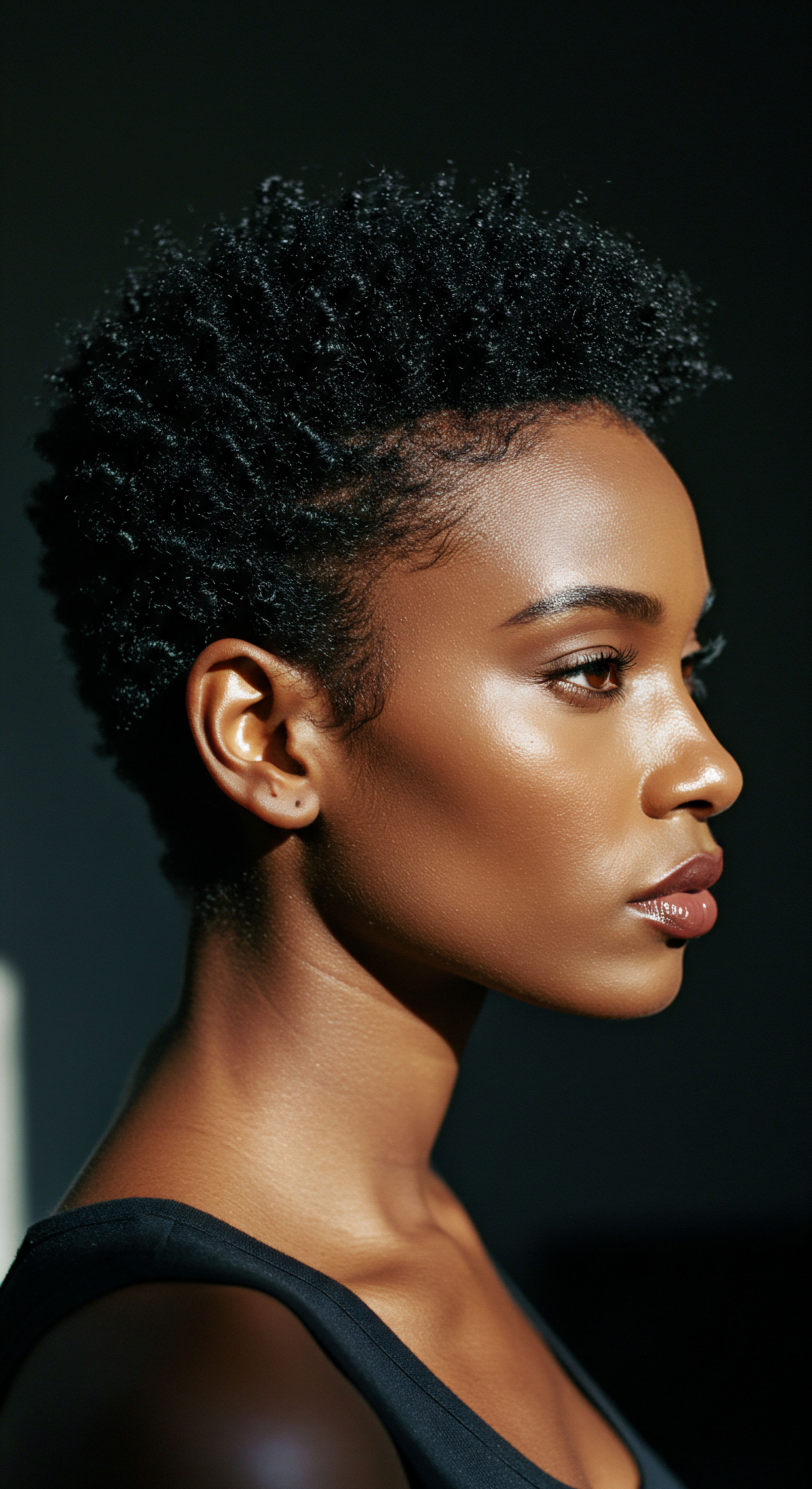
Roots
The quiet murmur of generations past often carries whispers of wisdom, a gentle guidance that resonates even in our swift-moving present. When we turn our attention to the simple, yet profound, act of hair care throughout history, a remarkable truth begins to surface. Our ancestors, living in intimate accord with their surroundings, cultivated practices for their strands that extended beyond mere appearance. These traditions, born of necessity and ingenuity, offer more than just beauty secrets; they present a compelling blueprint for sustainability, a path toward tending to our hair with thoughtful consideration for the earth that nourishes us all.
Consider the sun-drenched landscapes where ingredients were not shipped across oceans, but gathered from the soil beneath one’s feet. The ingenuity of these practices lay in their reliance on the immediate, the seasonal, and the regenerative. Every herb, every oil, every natural pigment was a gift from the local ecosystem, used with reverence and often returned to the earth without lingering harm. This inherent circularity, a dance between human need and natural cycles, holds profound lessons for a world grappling with the weight of its consumption.

What Wisdom Did Ancient Hair Care Practices Offer?
Long before the advent of industrial chemistry, communities across the globe possessed an intuitive understanding of botanical properties. Their hair remedies were not formulated in sterile laboratories, but discovered through centuries of observation and shared knowledge. These were systems of care deeply rooted in the environment, where the rhythm of nature dictated the ingredients available and the methods employed. The earth provided, and the people, in turn, respected its generosity.
- Botanical Reliance ❉ Many ancient societies utilized a wide array of plants, leaves, seeds, and roots for cleansing, conditioning, and coloring hair. From the saponins in yucca root that created natural lathers in the Americas to the nourishing qualities of hibiscus and amla in India, botanical wealth formed the bedrock of their regimens.
- Local Sourcing ❉ The geographical location profoundly influenced the ingredients used. African communities, for instance, relied on indigenous plants like the Chebe tree or the shea nut, while Mediterranean cultures turned to olive oil and herbs prevalent in their region. This minimized transportation and fostered a deep connection to local biodiversity.
- Multi-Purpose Ingredients ❉ Often, a single ingredient served multiple functions, reducing the need for numerous specialized products. Shea butter, a staple in many African hair care traditions, not only moisturized strands but also protected skin from harsh environmental conditions. This resourcefulness meant less production, less waste, and a simpler approach to personal care.

The Earth’s Bounty in Hair Care
The materials our ancestors chose for their hair were, by and large, biodegradable. Clay washes, herbal rinses, and plant-based oils would return to the earth, leaving no lasting trace. This stands in stark contrast to many contemporary hair care products, which often contain synthetic polymers and persistent chemicals that accumulate in waterways and soil, posing environmental concerns.
Consider the practice of using Rhassoul Clay from the Atlas Mountains of Morocco. This mineral-rich clay was used to cleanse hair and scalp without stripping natural oils, effectively removing impurities and product buildup. Once rinsed, it would simply dissolve back into the earth, enriching it rather than polluting it.
This echoes a fundamental principle of sustainable living ❉ taking only what is needed and ensuring that what is returned causes no harm. The careful selection of natural elements was not a trend, but a way of life, ensuring that hair care was an act of reciprocity with the natural world.
Ancient hair care practices reveal a profound wisdom in their reliance on locally sourced, multi-purpose, and biodegradable natural ingredients, fostering a reciprocal relationship with the environment.
| Ingredient Chebe Powder |
| Primary Origin Chad, Central Africa |
| Traditional Use Length retention, moisture, thickness, anti-inflammatory for scalp. |
| Ingredient Rooibos Tea |
| Primary Origin South Africa |
| Traditional Use Hair growth, antimicrobial, antioxidant, shine. |
| Ingredient Rhassoul Clay |
| Primary Origin Atlas Mountains, Morocco |
| Traditional Use Cleansing, impurity removal, scalp pH balance. |
| Ingredient Shea Butter |
| Primary Origin Sahel Belt, Africa |
| Traditional Use Moisturizing, protection, skin and hair health. |
| Ingredient Amla (Indian Gooseberry) |
| Primary Origin India |
| Traditional Use Nourishing scalp, strengthening hair, preventing premature graying. |
| Ingredient Rice Water |
| Primary Origin China, Japan |
| Traditional Use Strengthening, adding shine, promoting growth. |
| Ingredient Olive Oil |
| Primary Origin Mediterranean (Greece, Rome) |
| Traditional Use Conditioning, softening, shine, scalp nourishment. |

Ritual
As our understanding deepens, we move from the foundational knowledge of historical ingredients to the deliberate actions and shared customs that shaped hair care. The term ‘ritual’ here speaks to the intentionality, the repetition, and the cultural significance embedded in these practices. It invites us to consider how daily or periodic acts of tending to hair were not merely chores, but opportunities for connection – to self, to community, and to the natural world. This section offers a gentle invitation to explore the applied wisdom of the past, seeking practical lessons that might guide our present-day routines toward greater harmony and less environmental strain.
The rhythms of life in ancient societies often dictated a more measured approach to personal grooming. Hair washing, for instance, might not have been a daily affair, relying instead on methods that extended cleanliness and scalp health without constant water use. This deliberate pace allowed for deeper nourishment and a more mindful interaction with one’s hair. The emphasis was on maintaining the inherent vitality of the strands rather than subjecting them to harsh, frequent interventions.

How Did Ancient Hair Care Practices Conserve Resources?
The conservation of resources was an inherent outcome of historical hair care, not a separate objective. When ingredients were locally sourced, often cultivated or gathered by hand, their value was intrinsically understood. This led to practices that minimized waste and maximized the utility of each component.
- Water-Wise Washing ❉ Many traditional cleansing methods did not rely on copious amounts of running water. Clay washes, dry shampoos made from herbs and powders, or even simple rinses with specific plant infusions offered effective alternatives to modern lather-rinse cycles. Medieval Europe, for example, saw the use of dry shampoos to absorb excess oil, extending the time between washes. This directly addresses the significant water footprint of contemporary hair care.
- Minimal Processing ❉ Ingredients were typically used in their raw or minimally processed forms, reducing the energy and resources needed for manufacturing. Oils were cold-pressed, herbs dried and ground, and clays simply collected. This stands in stark contrast to the complex chemical syntheses and multi-stage industrial processes behind many modern products.
- Durability of Tools ❉ Tools for hair care were often crafted from natural, durable materials like wood, bone, or horn, designed to last for generations. Neem wooden combs, still used today, are known for their longevity and beneficial properties for scalp health, presenting a zero-waste alternative to plastic combs. These items were repaired when broken, not simply discarded.

The Art of Length Retention and Protection
Beyond cleansing, many historical practices centered on protecting hair from environmental stressors and promoting length retention, thereby reducing the need for frequent cuts or artificial extensions. This holistic view of hair health meant fewer interventions and a longer lifespan for the strands themselves.
The Basara Arab women of Chad provide a compelling example with their use of Chebe Powder. This unique mixture of herbs, seeds, and plants is applied to the hair, which is then braided and left undisturbed for days. This method doesn’t directly stimulate hair growth from the scalp but significantly aids in length retention by preventing breakage and sealing in moisture, particularly for coily hair types.
This deliberate approach contrasts sharply with the contemporary cycle of damage and repair, often driven by chemical processes or excessive heat styling. It is a quiet testament to the power of patience and gentle preservation.
Historical hair care rituals, with their water-wise washing, minimal processing, and emphasis on hair protection, offer tangible methods for reducing resource consumption and waste.
The use of protective styles, such as African threading and various braiding techniques, also played a crucial role in safeguarding hair. These styles minimized manipulation, protected the ends, and allowed hair to grow undisturbed, reducing breakage and the need for constant product application. This approach highlights a mindful interaction with hair, where its natural state is respected and preserved.
| Practice Chebe Powder Application |
| Region Chad, Central Africa |
| Sustainability Aspect Length retention, reduced breakage, less need for frequent cuts or products. |
| Practice Rhassoul Clay Washes |
| Region Morocco |
| Sustainability Aspect Water conservation, biodegradable cleanser, avoids synthetic chemicals. |
| Practice Herbal Rinses |
| Region Various (e.g. Europe, India) |
| Sustainability Aspect Natural conditioning, avoids synthetic conditioners, minimal environmental impact. |
| Practice Oil Massages |
| Region India (Ayurveda), Africa, Mediterranean |
| Sustainability Aspect Nourishment, promotes scalp health, reduces need for styling products. |
| Practice African Threading/Braiding |
| Region West Africa |
| Sustainability Aspect Protective styling, reduces manipulation and breakage, promotes length. |

Relay
Our contemplation now deepens, moving beyond the obvious lessons to the intricate interplay of culture, science, and environmental consequence. This section considers how historical hair care practices, when viewed through a contemporary lens, illuminate profound truths about our relationship with resources and our very well-being. It is here that we truly connect the delicate pastel warmth of Roothea’s spirit with the grounded, rigorous knowledge of the scientist and the cultural observer. We invite a moment of reflection on the subtle yet significant ways past wisdom can inform a more conscientious present.
The modern beauty industry, while offering convenience and variety, has introduced a cascade of environmental burdens. From the sheer volume of plastic packaging that chokes our landfills and oceans to the chemical runoff that contaminates waterways, the ecological footprint of our current hair care habits is undeniable. The historical approach, with its inherent resourcefulness and circularity, presents a compelling counter-narrative, one that challenges us to reconsider the true cost of convenience.

What Environmental Impact Do Modern Hair Products Carry?
The contrast between historical practices and modern conventions becomes stark when examining the environmental toll. The beauty industry, as a whole, generates a significant amount of waste and pollution. A substantial portion of this comes from hair care.
A significant contributor to the beauty industry’s environmental impact is plastic packaging, with an estimated 120 billion units produced globally each year. The vast majority of this packaging, around 95%, is discarded, often ending up in landfills or polluting natural environments. Even when packaging is recyclable, the reality is that only a small percentage, as low as 9% in some regions, actually gets recycled. This leaves a vast amount of plastic to persist in the environment for centuries.
Beyond packaging, the ingredients themselves pose challenges. Many modern hair products contain synthetic chemicals that can harm aquatic life and contribute to water pollution when rinsed down drains. Consider the pervasive issue of Microplastics.
These tiny plastic particles, often added to cosmetics for texture or exfoliation, are increasingly found in marine environments and even in human bodies. While much research and regulation have focused on “rinse-off” products like scrubs, a significant gap exists concerning “leave-on” cosmetics, which include many hair styling and conditioning products.
The historical wisdom of natural hair care stands in stark contrast to the environmental burdens of modern products, particularly the pervasive issue of microplastic pollution from “leave-on” formulations.
A compelling insight comes from a University of Birmingham study, which revealed a striking oversight ❉ out of 2,381 cosmetic products analyzed across 38 studies, a mere two were “leave-on” products. This indicates a critical lack of research into the microplastic contribution and potential health effects of products that remain on our skin and hair for extended periods. Furthermore, the European Union’s microplastic ban, while a step forward, will only fully apply to “leave-on” cosmetics by 2029, and for lip, nail, and makeup products, not until 2035. This delayed regulatory action, coupled with the research gap, underscores a silent, persistent environmental challenge that historical practices simply bypassed.

Can Traditional Hair Care Practices Offer a Solution to Modern Waste?
The historical approach to hair care offers a powerful lens through which to view solutions for modern waste. It champions a return to foundational principles that minimize consumption and maximize natural resources.
- Zero-Waste Principles ❉ Many historical practices inherently aligned with zero-waste ideals. Ingredients were biodegradable, tools were durable and repaired, and packaging was either absent or compostable (e.g. leaves, gourds). This contrasts with the current reliance on single-use plastics and complex, non-recyclable containers.
- Ingredient Transparency ❉ When ingredients were harvested from the local environment, their origin and composition were clear. This direct relationship fostered an innate understanding of what was being applied to the hair and scalp. Modern consumers often grapple with deciphering lengthy ingredient lists, many components of which are synthetically derived and of unknown environmental impact.
- Reduced Carbon Footprint ❉ The localized nature of sourcing and production in historical contexts meant a significantly smaller carbon footprint. Without global supply chains and industrial manufacturing, the energy consumption associated with hair care was minimal. Modern hair care’s carbon footprint is substantial, with a large proportion stemming from raw material sourcing and consumer use (particularly heating water).
The lessons from the past are not about replicating ancient methods precisely, but rather about adopting their underlying philosophies. It is about fostering a deeper respect for natural resources, prioritizing ingredients that return to the earth without harm, and cultivating a mindful relationship with our hair that extends beyond fleeting trends. This thoughtful consideration can lead to a more sustainable and ultimately more harmonious approach to personal care.
By examining the historical use of natural ingredients and practices, we find a clear path toward reducing the environmental impact of modern hair care, particularly in addressing packaging waste and microplastic pollution.
| Aspect Ingredients |
| Traditional Practices Natural, plant-based, biodegradable. |
| Modern Industry Synthetic chemicals, petroleum-derived, microplastics. |
| Aspect Packaging |
| Traditional Practices Minimal to none, natural materials (leaves, gourds). |
| Modern Industry Vast plastic waste (120 billion units/year globally). |
| Aspect Water Use |
| Traditional Practices Often water-wise methods, less frequent washing. |
| Modern Industry High water consumption in product use and manufacturing. |
| Aspect Carbon Footprint |
| Traditional Practices Low (local sourcing, minimal processing). |
| Modern Industry High (global supply chains, energy-intensive production, hot water use). |
| Aspect Waste Disposal |
| Traditional Practices Biodegradable, compostable. |
| Modern Industry Non-biodegradable, persistent pollutants, microplastic accumulation. |

Reflection
As we gently close this exploration of historical hair care, a profound sense of quiet understanding remains. The practices of our ancestors were not simply about adornment; they were expressions of deep connection to the earth, to community, and to self. The lessons they offer extend beyond the strands of our hair, reaching into the very core of what it means to live sustainably.
Perhaps the most enduring wisdom lies in recognizing that true beauty blossoms when we align our daily rituals with the natural world, allowing for reciprocity and respect. Our hair, then, becomes not just a part of our physical being, but a living testament to a thoughtful, harmonious existence.

References
- Byrd, Ayana, and Lori Tharps. Hair Story ❉ Untangling the Roots of Black Hair in America. St. Martin’s Griffin, 2001.
- Jacobs-Huey, Lanita. From the Kitchen to the Parlor ❉ Language and Becoming in African American Women’s Hair Care. Oxford University Press, 2006.
- Kukkola, Anna, et al. “Microplastics in Cosmetics and Personal Care Products ❉ A Critical Review.” Journal of Hazardous Materials, 2024.
- Tarlo, Emma. Entanglement ❉ The Secret Lives of Hair. Oneworld Publications, 2016.
- Weitz, Rose. Rapunzel’s Daughters ❉ What Women’s Hair Tells Us about Women’s Lives. Farrar, Straus and Giroux, 2004.
- Wingfield, Adia Harvey. Doing Business with Beauty ❉ Black Women, Hair Salons, and the Racial Enclave Economy. University of California Press, 2010.